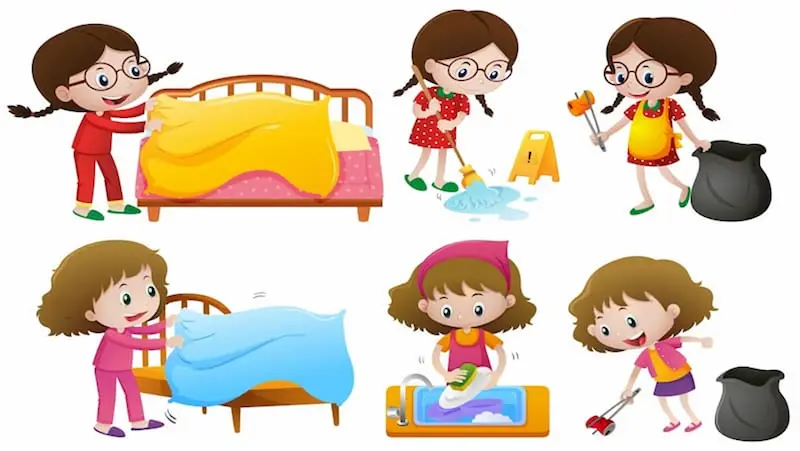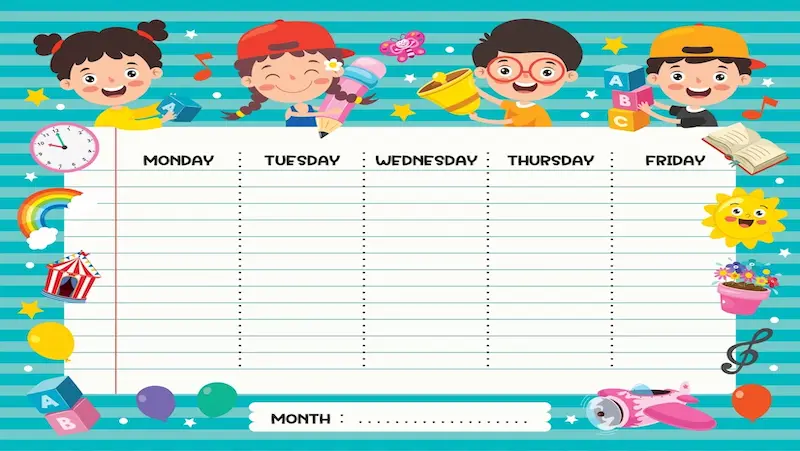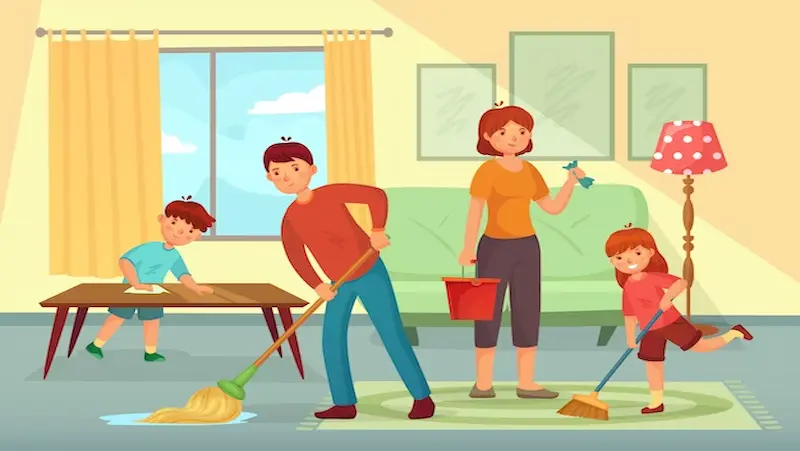Are you looking for an effective way to engage your kids in chores while promoting responsibility and organization? Introducing the Effective Chore Chart for Kids!
This visual tool provides a structured system to track and monitor your children’s progress, fostering a sense of accountability and time management. With clear tasks, incentives, and regular reviews, the Chore Chart empowers kids to take ownership of their responsibilities, paving the way for valuable life skills and a harmonious household.
Table of contents
Introduction
As parents, one of the key aspects of parenting is finding the right parenting style that aligns with your family values and goals. Nurturing a sense of responsibility and imparting essential life skills to young children are vital components of their overall development. Chores for kids serve as a valuable platform for instilling these qualities and teaching the significance of contributing to the family unit.
Incorporating an effective chore chart for kids can also contribute to their development of essential life skills, such as anger management for kids, by instilling a sense of responsibility and accomplishment.
Yet, without a well-defined structure, managing and organizing chores can quickly become an uphill battle. Are you eager to teach your children responsibility and valuable life skills through engaging tasks but struggle to motivate them without resorting to constant nagging or bribing?
In this article, we will show you how to create an effective chore chart for kids of different ages. We will also share some tips and ideas on how to make chores fun and easy for your family.
Age Appropriate Chores
Before you create a chore chart, you need to decide what chores are suitable for your kids. Well-designed chore chart for kids can play a significant role in fostering positive child development by instilling responsibility and a sense of accomplishment from completing tasks.
Incorporating mindfulness exercises for kids into your chore chart can foster a sense of calm and focus, enhancing the overall effectiveness of the routine.
Depending on their age and abilities, some tasks may be too easy or too hard for them. Here are some examples of age-appropriate chores for different age groups:
- Toddlers (2-3 years): They can do simple tasks that involve picking up or putting away things. For example, they can put their toys in a bin, throw away trash, or wipe up spills.
- Preschoolers (4-5 years): Assisting with setting the table, feeding pets, making their beds, and watering plants.
- Elementary School Kids (6-10 years): Watering plants, folding clothes, emptying small garbage bins, dusting and sweeping the house.
- Tweens (11-13 years): Vacuuming, washing dishes, gardening, and helping with meal preparation.

Creating a Chore Chart
A chore chart provides a visual representation of tasks and responsibilities, helping kids stay organized and accountable. Utilizing a well-designed chore chart is a fantastic way of teaching kids responsibility from an early age, fostering essential life skills that will benefit them in the long run.
Here’s how you can create an effective chore chart:
- Printable: You can find many free printable chore charts online that you can download and print. You can also create your own using a word processor or a spreadsheet program.
- Digital: You can use apps or websites that allow you to create and manage digital chore charts. You can also use online tools like Google Calendar or Trello to assign and track chores.
- DIY: You can make your own chore chart using materials like cardboard, magnets, stickers, or dry-erase markers. You can also use creative ideas like using a jar of marbles or a spinner wheel to assign chores.
Steps to create a chore chart
A well-designed chore chart for kids activities can bring structure and responsibility into their daily routines.
1. Choose a type of chart that suits your needs and preferences.
2. Decide how many chores and how often you want your kids to do them. You can assign daily, weekly, or monthly chores depending on the frequency and difficulty of the tasks.
3. Write down the chores and the rewards on the chart. You can use words, pictures, symbols, or colors to represent them. Make sure the chart is clear, interesting, and easy to understand.
4. Display the chart in a visible place where your kids can see it every day.
5. Explain the rules and expectations of the chart to your kids. Make sure they understand what they have to do and what they will get in return.

Making Chores Fun
Incorporating fun activities for kids into your chore chart can make household tasks an exciting adventure for young ones. Making chores enjoyable for kids can significantly improve their motivation and engagement. It can be a great way to instill a sense of responsibility and teach them valuable life skills. Here are some creative ideas and strategies to make chores enjoyable:
1. Gamify Chores:
– Create a point system: Assign points to different chores and let kids accumulate points for completing tasks. They can redeem the points for rewards later.
– Turn it into a race: Set a timer and challenge your kids to complete their chores before the timer runs out. Offer a small reward for finishing within the allotted time.
– Chore Bingo: Create a chore bingo card with different chores in each square. Kids can mark off squares as they complete tasks and earn rewards for completing a line or the entire card.
2. Create a Chore Chart:
– Use colorful and visually appealing charts: When creating an effective chore chart for kids, incorporating engaging and interactive worksheets for kids can make the process of assigning and tracking chores both educational and fun. Design a chore chart with vibrant colors and images that excite kids. Let them personalize their charts with stickers or drawings.
– Theme-based charts: Make chore charts based on your child’s interests, such as superheroes, animals, or their favorite TV shows. This adds an element of fun and engagement.
– Progress tracking: Incorporate a progress tracker on the chart, such as filling in a bar or coloring a section, to visually show the completion of tasks over time.
3. Turn Chores into Challenges:
– Time challenges: Challenge your kids to beat their previous chore completion times or set specific time goals for completing certain tasks. Make it a friendly competition.
– Skill-based challenges: Encourage kids to improve their skills while doing chores. For example, challenge them to fold clothes neatly or stack dishes without breaking any.
– Chore relay: Create a relay race-style chore activity where each family member performs a specific task before passing it on to the next person. This adds an element of teamwork and fun.
4. Incorporate Music and Dance:
– Create a chore playlist: Make a special playlist with upbeat and energetic songs that your kids enjoy. Encourage them to dance or sing along while completing their chores.
– Choreography challenges: Teach your kids simple dance moves and challenge them to incorporate those moves while doing chores. It can turn a mundane task into a mini dance party.
5. Provide Rewards and Incentives:
– Reward system: Offer small rewards like stickers, stars, or tokens for completing chores. Accumulated rewards can be exchanged for a larger prize or privilege.
– Surprise rewards: Hide surprise rewards or small treats around the house for your kids to discover when they complete their chores. It adds an element of excitement and surprise.
Remember, it’s important to strike a balance between making chores enjoyable and teaching responsibility. Encourage your kids to take ownership of their tasks and gradually reduce the need for external rewards as they develop intrinsic motivation.

Establishing a Routine
Consistency and routine play a vital role in implementing chore charts effectively. Here’s why they are important and some practical tips for integrating chores into daily or weekly routines:
Importance of Consistency and Routine
1. Establishing habits: Consistency helps develop good habits for kids. When chores are consistently assigned and completed at specific times, they become part of a routine and are more likely to be ingrained as lifelong habits.
2. Predictability and stability: Routines provide a sense of predictability and stability for children. Knowing what to expect and when to expect it reduces anxiety and resistance towards chores.
3. Building responsibility: Consistency in chore expectations teaches children the importance of fulfilling responsibilities consistently, which is a valuable life skill.
4. Time management skills: Incorporating chores into a routine helps children learn time management skills as they allocate specific time slots for their tasks.

Practical Tips for Integrating Chores into Routines
1. Set a consistent schedule: Assign specific times for chores each day or allocate certain days of the week for particular tasks. Consistency in timing helps children anticipate and plan accordingly.
2. Morning and evening routines: Include a few short tasks as part of morning and evening routines. For example, making the bed, tidying up personal belongings, or loading the dishwasher can be part of the morning routine, while organizing toys or preparing for the next day can be included in the evening routine.
3. Family chore time: Designate a specific time each day or week when the entire family participates in chores together. This promotes teamwork, provides support, and makes chores feel less daunting.
4. Age-appropriate tasks: Assign chores according to your child’s age and abilities. Start with simple tasks and gradually introduce more complex responsibilities as they grow older. This helps children feel capable and successful in completing their assigned chores.
5. Clear expectations: Clearly communicate the expectations for each chore. Use visual cues, such as chore charts or written instructions, to provide clarity and help children understand what needs to be done.
6. Celebrate accomplishments: Acknowledge and appreciate your child’s efforts and completion of chores. Offer praise, positive reinforcement, or small rewards to reinforce their consistency and efforts.
Remember, it’s important to be flexible within the routine to accommodate unexpected events or changes. Consistency does not mean rigidity and occasional adjustments can be made while still maintaining the overall structure and expectations of the chore routine.

Tracking Progress and Adjusting
Tracking and monitoring kids’ progress using a chore chart is an effective way to keep tabs on their responsibilities and provide feedback. Here’s how you can track and monitor progress using a chore chart and guidance on adjusting tasks as kids grow older:
1. Design the Chore Chart:
– Create a visual chart: Use a poster board, whiteboard, or an online chore chart template to clearly display the assigned tasks and their corresponding completion status.
– Include names and tasks: Write each child’s name and list their assigned chores next to their names. This ensures clarity and individual accountability.
– Use visuals and symbols: Incorporate visuals such as icons, stickers, or color codes to represent completed tasks. This makes it easier for kids to see their progress at a glance.
2. Tracking Progress:
– Daily/weekly checkmarks: Encourage children to mark or check off completed tasks on the chart themselves. This empowers them to take ownership of their responsibilities.
– Color-coded system: Assign different colors to represent completed, partially completed, and incomplete tasks. This provides a visual representation of progress.
– Reward points or stars: Award points or stars on the chart for each completed task. Accumulated points can be used for rewards or privileges.
3. Monitoring Progress:
– Regular review: Set aside dedicated time each week to review the chore chart with your child. Discuss their accomplishments, provide feedback, and address any concerns or difficulties.
– Celebrate milestones: Recognize and celebrate milestones or achievements on the chore chart. This boosts motivation and reinforces positive behavior.
– Provide constructive feedback: Offer specific feedback on their performance, highlighting areas where they excel and areas for improvement. This helps them understand expectations and grow in their responsibilities.
Adjusting Tasks and Responsibilities as Kids Grow Older
1. Gradual increase in difficulty: As children grow older, gradually introduce more complex tasks and responsibilities that align with their age and abilities. This allows them to develop new skills and take on more challenging chores.
2. Delegate age-appropriate tasks: Assign tasks that are suitable for their developmental stage and encourage their independence. This fosters a sense of competence and self-reliance.
3. Collaborative decision-making: Involve children in discussions about their tasks and responsibilities. Seek their input and preferences to ensure they feel a sense of ownership and are more likely to engage in completing the chores.
4. Recognize strengths and interests: Take note of your child’s strengths and interests and consider assigning tasks that align with their abilities and passions. This increases their engagement and motivation.
5. Regular evaluation: Evaluate the suitability of assigned chores periodically. Assess if they are challenging enough or if adjustments need to be made based on your child’s growth, skill development, or changing circumstances.
Remember, open communication and flexibility are key when adjusting tasks and responsibilities. Regularly check in with your child, solicit their input, and make adjustments as necessary to ensure their continued growth and engagement in their chores.

Encouraging Responsibility and Life Skills
Chores play a crucial role in the development of responsibility, time management, and other valuable life skills in children. Here’s how chores contribute to their overall development and the long-term benefits they offer as kids become self-sufficient adults:
1. Responsibility:
– Accountability: Chores teach children to take ownership of their assigned tasks and be accountable for completing them. They learn that their actions and contributions have an impact on the functioning and well-being of the family.
– Follow-through: By consistently completing chores, children develop a sense of responsibility and learn the importance of following through on commitments, even when the tasks may be mundane or challenging.
– Consequences: Chores provide children with a tangible understanding of cause and effect. They learn that neglecting their responsibilities may result in negative consequences, such as a messy environment or strained family dynamics.
2. Time Management:
– Prioritization: When children have assigned chores, they need to manage their time effectively and prioritize their tasks. They learn to allocate time for chores alongside other commitments, such as schoolwork, extracurricular activities, and personal interests.
– Task organization: Chores teach children the importance of organizing and planning their tasks. They develop skills in breaking down larger tasks into smaller, manageable steps, which aids in efficient time management.
– Deadlines and timeliness: By having specific chores to complete within given timeframes, children learn to meet deadlines and understand the importance of punctuality.
3. Self-discipline and Work Ethic:
– Consistency and perseverance: Regular engagement in chores instills a sense of self-discipline and the value of consistent effort. Children learn to persevere and complete tasks even when they may not feel like doing so.
– Work ethic: Chores provide an opportunity for children to develop a strong work ethic. They understand that hard work and dedication are essential for accomplishing goals and maintaining a functional household.
4. Collaboration and Teamwork:
– Cooperation: Chores often require cooperation and collaboration with other family members. Children learn to work together, communicate effectively, and contribute as part of a team.
– Empathy and shared responsibility: Participating in household chores fosters empathy and an understanding of shared responsibility. Children realize that everyone has their own tasks and contribute to the well-being of the family unit.

Long-term Benefits as Kids Become Self-sufficient Adults
1. Independence: Through chores, children gain the skills and confidence to become independent individuals. They develop the ability to manage their living spaces, handle household tasks, and take care of themselves when they eventually leave home.
2. Organizational skills: Chores promote organizational skills, as children learn to plan, prioritize, and manage their time effectively. These skills are transferable to various aspects of life, such as work, studies, and personal responsibilities.
3. Self-reliance: By regularly engaging in chores, children become self-reliant and capable of handling various tasks and challenges on their own. They develop problem-solving skills and the ability to adapt to different situations.
4. Contribution to the community: Chores teach children the importance of contributing to their community, whether it’s their family or a larger social unit. As they become adults, they are more likely to actively participate and contribute to their communities.
Overall, chores provide children with invaluable life skills that are essential for their personal growth, independence, and success in adulthood. By instilling a sense of responsibility, time management, and a strong work ethic, children are well-prepared to become self-sufficient and contributing members of society.
Conclusion
Implementing a chore chart for kids is an effective way to teach responsibility and valuable life skills. Incorporating a well-structured chore chart for kids not only teaches responsibility but also promotes their overall kids’ health by encouraging active engagement and a sense of accomplishment. By assigning age-appropriate tasks, creating an engaging chart, establishing routines, and monitoring progress, children learn the importance of contributing to the family and developing essential skills for their future. So, start implementing a chore chart today and witness the positive impact it has on your child’s growth.
Ready to ignite your child’s potential? Explore the exciting world of robotics, financial education, and coding courses for kids with Brightchamps – where learning meets innovation!
Frequently Asked Questions
It’s never too early to start involving children in household chores. Simple tasks can be introduced as early as 2-3 years old.
Consider using a rewards system, turning chores into games, or offering praise and encouragement for a job well done.
The choice depends on your child’s preferences and your need for flexibility. Digital charts offer convenience, while printable ones can be customized and decorated.
Preschoolers can assist with setting the table, feeding pets, making their beds, and watering plants.
Evaluate and update the chart regularly to reflect your child’s growth and evolving capabilities.
Rewards can serve as motivation, but they are not essential. Some children find intrinsic satisfaction in completing tasks.
Turn chores into games, use themed chore charts, or play music or audiobooks while completing tasks.
Communicate the importance of their contributions, offer incentives, or establish consequences for not fulfilling responsibilities.
Let your child participate in selecting tasks, designing the chart, and setting rewards. This promotes a sense of ownership.
Coordinate schedules, assign tasks that suit each family member’s availability, and prioritize teamwork to manage chores effectively in a busy household.


 We are an army of educators and passionate learners from BrightChamps family, committed to providing free learning resources to kids, parents & students.
We are an army of educators and passionate learners from BrightChamps family, committed to providing free learning resources to kids, parents & students.











